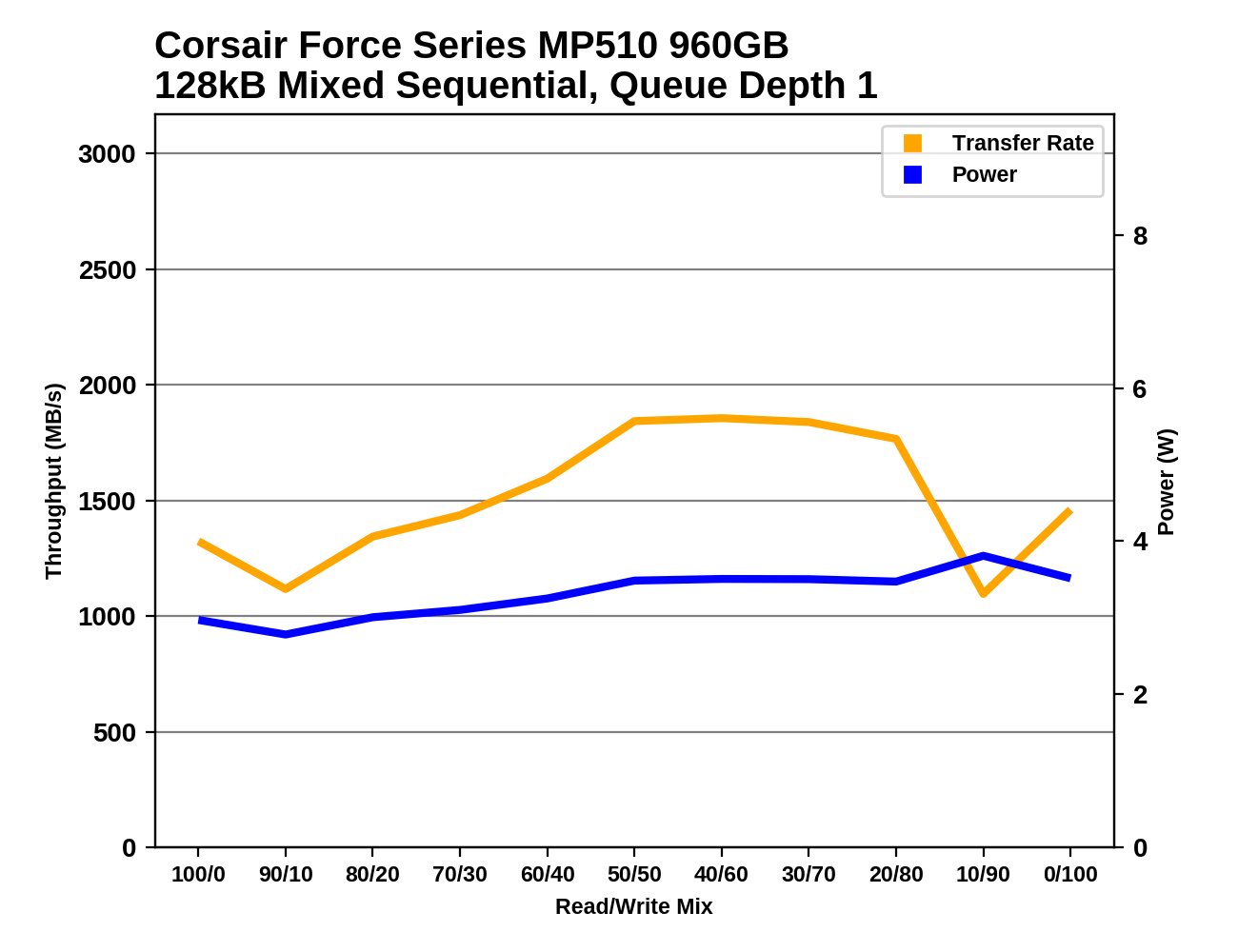The Corsair Force MP510 SSD (960GB) Review: A High-End Contender
by Billy Tallis on October 18, 2018 10:00 AM ESTMixed Random Performance
Our test of mixed random reads and writes covers mixes varying from pure reads to pure writes at 10% increments. Each mix is tested for up to 1 minute or 32GB of data transferred. The test is conducted with a queue depth of 4, and is limited to a 64GB span of the drive. In between each mix, the drive is given idle time of up to one minute so that the overall duty cycle is 50%.

The Corsair Force MP510 demonstrated above average random read performance and top tier random writes, but the mixed workload results are average at best. The WD Black averages about 18% higher performance with the same NAND, and the Samsung 970 EVO is about 40% faster.
 |
|||||||||
| Power Efficiency in MB/s/W | Average Power in W | ||||||||
As with performance, the power efficiency score from the MP510 is acceptable but nothing special compared to the Toshiba XG6 and WD Black.
 |
|||||||||
The unimpressive overall score from the MP510 on the mixed random I/O test seems to primarily stem from how it behaves during the more write-heavy half of the test. As the proportion of writes grows, the performance of the MP510 increases relatively slowly until the very end when performance spikes on the 100% cachable pure random write phase of the test.
Mixed Sequential Performance
Our test of mixed sequential reads and writes differs from the mixed random I/O test by performing 128kB sequential accesses rather than 4kB accesses at random locations, and the sequential test is conducted at queue depth 1. The range of mixes tested is the same, and the timing and limits on data transfers are also the same as above.

The Corsair Force MP510 provides excellent performance on our mixed sequential I/O test, but for once appears to be slightly slower than the Phison E12 engineering sample we tested earlier this year.
 |
|||||||||
| Power Efficiency in MB/s/W | Average Power in W | ||||||||
The MP510 turns in an extremely good power efficiency score for the mixed sequential I/O test: only about 4% behind the class-leading WD Black, and 50% better than the HP EX920.
 |
|||||||||
The performance curve of the Corsair Force MP510 on the mixed sequential I/O test looks rather unusual, with performance jumping around a bit and at its best during the more write-heavy half of the test. Most drives show a more typical bathtub curve with the best performance at either end of the test, but the WD Black's behavior does show similarities to the MP510.










42 Comments
View All Comments
hugo.sousa - Wednesday, October 24, 2018 - link
Hi Bill,Where did you bought those refurbished drives?
goatfajitas - Thursday, October 18, 2018 - link
Yup, its easy enough to do it now on the cheap. A 1tb PCIe SSD for $235 (and a great performing one at that) for your data you access often and larger slower HDD's for less used data/backups etc.wumpus - Thursday, October 18, 2018 - link
HDDs are running $20/TB (Hitachi 3TB comes up cheapest on pcpartpicker), and even larger drives can be had cheap if you are willing to buy external drives on sale and "shuck" them.The real catch is that 90% of the people use about 100GB or so data, so sales of HDDs are pretty flat. So they stopped getting cheaper around 2011 and pretty much sat around waiting to be replaced by SDDs.
Prices are finally lower than 2011, but I really have to wonder if Moore's law has enough juice to get SDDs down to the level they need to kill off HDDs (in case you are wondering, tape is still alive and kicking. And makes all sorts of sense for storing data >100TB. I wonder if HDDs will go the same way "just for datahoarders".)
stargazera5 - Thursday, October 18, 2018 - link
@wumpus: "(in case you are wondering, tape is still alive and kicking. And makes all sorts of sense for storing data >100TB"Maybe tape looks good for >100TB, but there are a lot of us home power users who have 10-100 TB that could use a good WORM solution for backup. The cost of tape drives are quite high and drove TCO far too high to make good sense compared to buying additional HDDs a couple times a year, which isn't that cheap either and has far too low a frequency.
I also looked into online backup (e.g. Blackblaze, Carbonite, etc.) until I realized it would take 6 months to send them my base-line backup via my internet pipe (10 Mbps up)
No real good solutions here, but probably a pretty good market.
vanilla_gorilla - Thursday, October 18, 2018 - link
Some of those services offer disk based import/export options: https://aws.amazon.com/snowball/disk/details/Lolimaster - Thursday, October 18, 2018 - link
Crucial MX500 go to as low as 0.165 per GB.leexgx - Thursday, October 18, 2018 - link
""All capacities have a rated write endurance of around 0.9-1.0 drive writes per day and a five year warranty period, which are standard for high-end consumer SSDs""i thought 1.0 DWP was only for enterprise levels (most ssds have DWP of around 0.3)
Diji1 - Friday, October 19, 2018 - link
>You know, its getting to price points soon that home servers would easily use SSD drives vs mechanical.Er ... is it?
Diji1 - Friday, October 19, 2018 - link
Although there is no excuse for using spinning disks for the OS disk IMO.PaoDeTech - Thursday, October 18, 2018 - link
Please review Crucial P1 1TB 3D NAND NVMe PCIe M.2 SSD. I'm willing to pay $20 premium over SATA but not more. If the P1 1TB goes on black Friday sale for $179.99 I'll pull the trigger (MX500 1TB SATA is currently $159.99).Does anybody know what's the BOM cost difference between SATA and PCIe?